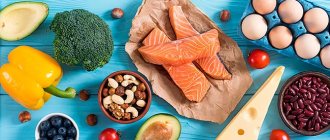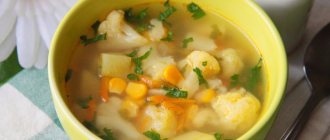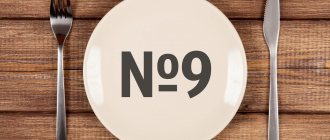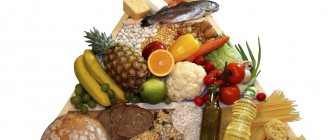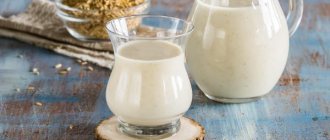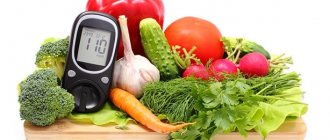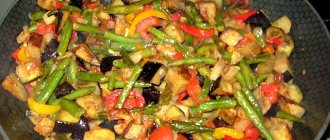Diet 4 table is a therapeutic diet, the main purpose of which is to reduce the load on the gastrointestinal tract and is prescribed for acute and chronic intestinal diseases, which are accompanied by diarrhea, bloating and other digestive disorders. Dietary table 4 is prescribed for a short period of time (from 3 to 7 days) for the following diseases:
- acute gastroenterocolitis;
- chronic colitis and enterocolitis in the acute phase;
- intestinal tuberculosis (first week of treatment);
- dysentery.
There are also types of dietary nutrition, such as table 4B, which is prescribed for exacerbation of colitis against the background of concomitant diseases (gastritis, pancreatitis, biliary dyskinesia), and table 4B, which is indicated for remission of gastrointestinal diseases.
What is diet No. 4 intended for and who developed it?
This type of treatment is prescribed for various acute and chronic diseases, such as colitis and chronic digestive disorders, which are accompanied by difficulties and problems with digestion and colon motility. The main goal of the diet is to have a gentle and maximally safe effect on the body, with any contraindications to the use of special drugs for the treatment of diseases of the digestive system. This diet is completely safe and effective if all recommendations are followed.
This diet is considered very effective for intestinal diseases with constipation, as it acts to create the necessary conditions for:
- “restart” of the entire gastrointestinal tract system;
- restoration of normal functioning of peristalsis.
The nutritional system was developed by the famous Soviet gastroenterologist Pevzner, and since ancient times, diet table No. 4 has been working effectively and efficiently.
The developed nutrition system includes all the most important and necessary conditions for treating problems with the intestines or stomach.
Both adults and children, even younger ones, can resort to this system.
Prohibited dishes on the menu
During the diet, it is strictly forbidden to consume the following foods and dishes, the recipes of which contain the following:
- Butter and puff pastries, fresh or rye bread;
- Soups with fatty broth or with the addition of legumes, rassolnik and okroshka;
- Smoked sausages and any canned food;
- Dairy products;
- Mushrooms and dishes made from them;
- Fried egg dishes;
- Garlic, onion and radish;
- Chocolate, ice cream, cakes;
- Horseradish and mustard, hot sauces.
Basic principles of diet No. 4
Any diet is aimed at:
- improvement of the physical condition of the body;
- restoration of organs by reducing the load;
- change in food quality.
In addition, when following a proper diet, not only the intestines are “unloaded,” but also the general metabolism in the body is normalized. Diet table No. 4 for intestinal diseases provides for certain rules and principles of nutrition.
The basic principles of the fourth diet are as follows:
- “Soft” effect on the intestines and stomach, absence of strong irritants to the membranes of the gastrointestinal tract.
- A diet that includes the lowest possible amount of carbohydrates in foods.
- High protein, easy to digest food.
- Compliance with nutritional conditions that minimize the load on the digestive organs: you should not eat food with sharp differences in temperature in relation to the temperature of the internal organs.
- Meals in small portions, which should be consumed in 4-7 meals a day.
What foods are good for the stomach?
Allowed dishes on the menu
Despite the fairly strict restrictions, the 4 “B” diet table provides a wide variety of delicious foods, which can be presented in table form:
- Lean meat, preferably beef, rabbit or chicken. Boiled. Be sure to remove the skin and cut out the tendons. Once a week you can allow yourself a couple of milk sausages, diet sausage or boiled tongue;
- Soft-boiled eggs or egg dishes are allowed no more than one egg per day;
- Low-fat fish can be baked, and a small amount can even be fried. But you can't cook breaded fish. You should also refrain from eating caviar;
- Vegetable soups or soups with lean meats are one of the main dishes of the diet. However, they should be very liquid and unsalted. You can also add cereals to the broth, everything except millet, potatoes, a small amount of pasta or noodles, carrots, cauliflower, zucchini, lean minced meatballs;
- Liquid porridge, with a small amount of sugar, possibly with the addition of honey or jam;
- Vegetables should make up the majority of the diet. It is recommended to consume vegetables steamed, boiled, in the form of jure or various casseroles. The best options are zucchini, potatoes, carrots, pumpkin, a little (no more than one hundred grams per day) well-boiled peas and beets, or ripe tomatoes;
- Fruits should be the main dessert. Fresh or baked apples will be useful. It is not recommended to consume more than one hundred grams of berries, and only ripe ones. Strawberries, raspberries, pears, thoroughly seeded watermelon, peeled grapes. Oranges and tangerines are allowed, but only in small quantities;
- In drinks, it is advisable to opt for compotes, juices heavily diluted with water and plain water. Coffee and cocoa are allowed, with a small amount of low-fat milk;
- In spices and sauces, it is better to limit yourself to cinnamon, dill and parsley, a small amount of vanillin and bay leaf. Suitable sauces include fruit and sour cream.
Allowed products at table number 4
Each diet has a number of acceptable foods, stop foods, as well as principles of food preparation. The diet has its own lists of permitted and prohibited foods, and compliance with these lists is a fundamental point. The principles of cooking play an important role, since with different methods of preparation and consumption, the same products affect the digestion process differently.
The table during diet 4, as well as a detailed description of what can and cannot be consumed is given below:
- Soft, pureed foods: this will reduce the load on the digestive system. The following dishes are allowed in this consistency: cutlets made from lean soft meat, porridge, ground cereal, soufflé, pureed meat and some fruit and vegetable purees.
- Protein foods: boiled meat, meat souffles, cottage cheese, boiled eggs.
- Drink: all kinds of dried fruit compotes, decoctions of some herbs, weak teas.
- Dairy products: natural yogurt, kefir, cottage cheese.
Consumption of all of the above products significantly affects the relief of intestinal function. With this menu the following are excluded:
- constipation;
- stomach upsets;
- diarrhea;
- other unpleasant consequences of gastrointestinal diseases.
Menu for table No. 4
Menu for table No. 4
| Eating | List of dishes |
| For breakfast | Liquid semolina porridge, pureed oatmeal, low-fat cottage cheese, grated apples, cocoa, baked pears or apples, green tea |
| For lunches | Broth with semolina, vegetable broth and pureed buckwheat, rice soup with meatballs, weak fish broth with herbs and rice, wheat crackers |
| For dinners | Mashed porridges from permitted grains, steamed cutlets, stewed fish and meatballs, semolina soufflé, meat puddings, baked fish (without skin) |
| For snacks | Homemade jelly, jellies, rosehip infusions, wheat crackers, berry and fruit infusions (without sugar), cocoa in water, baked pears and apples |
It is quite difficult to follow such a strict diet. The duration of the treatment course is determined by the doctor. As a rule, this is a short-term diet, so you will have to endure a little. After you feel better, the doctor prescribes a different diet. Let's look at some recipes that will help diversify your daily menu.
Rice cocoa recipe
To prepare you will need:
- 100 g rice;
- 1.5 liters of water;
- 50 g cocoa;
- a little sugar.
The washed rice should be completely boiled over low heat. Strain the resulting mass through cheesecloth. Grind cocoa with sugar until smooth. Pour cocoa into the rice broth and strain everything again. Serve the resulting drink warm. The recipe is suitable for all diet options and table No. 10.
Meat quenelles recipe
To prepare you will need:
- 100 g cottage cheese;
- 200 g beef (fillet without tendons and fascia);
- 1 chicken egg;
- 10 g butter.
The beef must be cut and minced twice. Rub the cottage cheese thoroughly through cheesecloth. Mix the minced meat and cottage cheese, add a little salt, beat in the egg, then add soft butter. Mix everything well and form quenelles. Steam for 20 minutes. The recipe is suitable for tables: 4, 4a, 4b, 4c.
Prohibited foods on diet No. 4
The complete exclusion of certain foods for intestinal diseases during diet table number 4 is a mandatory and necessary condition for a person’s recovery. Prohibited foods can cause such unpleasant consequences of consumption as:
- colitis;
- enterocolitis;
- inflammatory and putrefactive processes in the intestine.
Prohibited foods on diet table No. 4:
- fatty, fried foods;
- high carbohydrate foods;
- foods and drinks high in sugar or salt;
- products that have a strong temperature difference: ice cream, hot soups, drinks;
- fresh vegetables and some fruits, freshly squeezed concentrated and sour juices;
- sausages and frankfurters, smoked meat, lard and other fatty foods;
- fresh milk;
- “heavy” cereals (millet, pearl barley);
- Coffee and coffee drinks.
All these dishes must be completely excluded during the treatment of intestinal diseases.
Treatment table 4a
Diet 4a is prescribed for any intestinal dysfunction that is caused by increased gas formation, as well as for chronic colitis. To restore the digestive process, foods that cause oxidation are completely excluded from the treatment menu. This is the entire list of dishes and components for the 4th table. You should also limit the amount of chicken, fresh dairy products, completely eliminate raw vegetables and fruits, coffee, any sweets, and carbonated drinks.
The diet consists mainly of protein foods. Fats and carbohydrates are present in the diet in minimal quantities. As a rule, such a diet is prescribed for the first time of treatment, then the patient is transferred to another diet according to Pevzner. You should also strictly observe all three types of sparing. The rules for the diet are the same as in No. 4.
You can eat pureed, soft food warm. For flour products, soft noodles and white crackers are allowed. From dairy products you can eat low-fat and calcined cottage cheese, yogurt and kefir at night. Whole grain cereals are completely excluded, only crushed ones are allowed, from which it is easy to prepare mucous decoctions. Soups can be prepared using second fish and meat broths. It is better to draw up a complete list of products for colitis with a gastroenterologist, based on the patient’s condition.
Sample menu for the day for table 4a
For breakfast: sour cream cottage cheese, soft-boiled egg, tea.
For lunch: cream of meat soup, chopped vermicelli.
Afternoon snack: baked ripe apples.
For dinner: steamed meatballs from lean fish (hake, pike perch, cod).
A couple of hours before bedtime: 250 ml of kefir.
Calcined cottage cheese recipe
To prepare dietary cottage cheese, you will need calcium chloride or calcium lactic acid powder. For 0.5 liters of milk you need one and a half spoons of solution or 3 g of powder. The milk needs to be heated over low heat to about 400, without removing from the heat, add the powder or solution. As soon as the curd appears, it needs to be placed on cheesecloth to drain.
It is better to choose homemade milk, since store-bought cottage cheese may not produce at all, or it may produce too little. This cottage cheese is suitable for all four diet options.
Weekly menu for intestinal diseases
The weekly menu for intestinal diseases is selected based on the principle of maximizing the reduction of all negative consequences associated with food consumption. This allows the digestive organs to recover and establish full functioning. A week of nutrition following diet number 4 significantly reduces all manifestations and exacerbations of chronic gastrointestinal diseases.
If you take the daily norm during a diet, then the indicators should vary within the following limits:
- the total calorie content of foods consumed per day should not exceed 2100 kcal;
- the number of meals should not be less than 5 per day;
- portions should be small in size - for more efficient and simplified functioning of the intestines and stomach.
Diet table No. 4, designed for a weekly duration, is described in the table:
| Day of the week | 1st meal | 2nd meal | 3rd meal | 4th meal | 5th meal |
| Monday | Rice porridge made from round rice, low-fat steamed fish | Applesauce | Chicken broth with breast meat, dried fruit compote | Bagels or crackers without additives, green tea | Kefir, crackers |
| Tuesday | Oatmeal on water, steamed omelette | Soft curd mass, without additives, tea | Vegetable soup with rice or buckwheat, salad of boiled vegetables, tea | Tea or compote, dry cookies or non-yeast baked goods | Cookies, tea, a small amount of cottage cheese |
| Wednesday | Mashed potatoes with water, pate, tea and cookies | Cottage cheese casserole or manna, tea or jelly | Vegetable and lean meat soup, buckwheat porridge with chicken soufflé, non-acidic juice | Tea or juice, unsweetened waffles or unfilled cookies | Kefir |
| Thursday | Buckwheat porridge, a piece of chicken breast, tea or herbal decoction | Kefir, stewed vegetables, a slice of dried bread | Soup with meat and cereals, mashed potatoes with steamed cutlets, tea | Kefir or herbal decoction, cottage cheese casserole | Drying, kefir |
| Friday | Semolina porridge with apple, slice of bread | Steamed fish cutlets, vegetable stew | Lean meat soup with potatoes and rice, buckwheat porridge with chicken cutlets | Fruit puree, non-acidic juice, cookies | Cookies with tea |
| Saturday | Hercules on water with slices of chicken fillet, a slice of bread, tea | Fruit or vegetable puree, manna | Cream soup of pureed vegetables with croutons, noodles and stewed pork | Cottage cheese with fruit, tea and waffles | Kefir, tea and curd mass |
| Sunday | Semolina porridge, curd pudding, apple and tea | Dry cookies, fruit puree, jelly | Fish soup, puree, lean fish or meatballs | Omelette, cookies and tea | Tea, jelly and fruit puree |
Nutrition for intestinal diseases
Do's and don'ts
Recommended and excluded foods and dishes of the “4 table” diet:
Table “Dos and Don’ts”
| Products and dishes | What is possible | What not to do |
| Bread and flour products | Rusks from 200 g of premium wheat bread, thinly sliced and not crispy. | Other bakery and flour products. |
| Soups | In low-fat, weak meat or fish broth with the addition of mucous decoctions of cereals, semolina, rice, boiled and pureed meat, steamed quenelles and meatballs, egg flakes. | Soups with cereals, vegetables, pasta, milk, strong and fatty broths. |
| Meat and poultry | Lean and lean varieties of beef, veal, chicken, turkey, rabbit. The meat is degreased, fascia and tendons are removed, and in birds, the skin is removed. Steamed or boiled cutlets, quenelles, meatballs. Minced meat with boiled rice instead of bread is passed through a fine grinder 3-4 times. Boiled meat soufflé. | Fatty types and varieties of meat, pieces of meat, sausages and other meat products. |
| Fish | Low-fat types of fresh fish, cut into pieces and chopped (quenelles, meatballs, cutlets), boiled in steam or water. | Fatty species, salted fish, caviar, canned food. |
| Dairy | Freshly prepared calcined or unleavened mashed cottage cheese, steam soufflé. | Whole milk and other dairy products. |
| Eggs | Up to 1-2 pieces per day. Soft-boiled, steamed omelet and in dishes. | Hard-boiled eggs, fried. |
| Cereals | Puree porridges in water or low-fat broth - rice, oatmeal, buckwheat, cereal flour. | Millet, pearl barley, barley, pasta, legumes. |
| Vegetables | Only in the form of decoctions added to soups. | — |
| Snacks | Excluded from the diet. | — |
| Fruits, sweet dishes and sweets | Jelly and jelly from blueberries, dogwoods, bird cherry, quince, pears. Mashed raw apples. Sugar - limited. | Natural fruits and berries, dried fruits, compotes, honey jam and other sweets. |
| Sauces and spices | Only low-fat broth and butter in dishes. | — |
| Beverages | Tea, especially green, black coffee and cocoa with water. Decoctions of rose hips, dried blueberries, black currants, bird cherry, quince. If tolerated, diluted fresh juices from berries and fruits, except grapes, plums, and apricots. | Coffee and cocoa with milk, carbonated and cold drinks. |
| Fats | Only fresh butter, 5 g per serving of the finished dish. | Animal and cooking fats. |
Indications for use
This nutrition system in medicine and dietetics is used in the following cases:
- during the recovery period after previously suffered acute intestinal inflammation (including infectious, including typhoid fever, dysentery);
- in the presence of chronic intestinal pathologies (for example, colitis).
Doctors prescribe therapeutic diet 4b in the remission stage for gastrointestinal diseases.
Recipes for eggs and cottage cheese
Omelette with boiled meat and tomatoes
Cut the boiled meat into thin slices. Cut the tomatoes into cubes. Combine the egg with milk, add salt and beat well. Place meat, tomatoes in a frying pan greased with vegetable oil, pour in the egg-milk mixture, and steam. Before serving, sprinkle with dill.
Boiled meat 30 g, egg 2 pcs., tomatoes 10 g, milk 40 ml, dill 5 g, vegetable oil 3 ml.
Cottage cheese, semi-fat, not pureed
Place the cottage cheese on a plate, pour over sour cream and add a little honey.
Cottage cheese 100 g, sour cream 15% fat 20 g, honey 10 g.
Curd casserole with carrots
Grate the carrots on a coarse grater and simmer in a small amount of water with added oil until tender. Add milk, egg, sugar, semolina to the cottage cheese, mix well, add poached carrots, mix thoroughly again, place on a baking sheet greased with vegetable oil, level and bake in the oven. Serve with sour cream.
Low-fat cottage cheese 100 g, milk 30 ml, egg 1/4 pcs., granulated sugar 10 g, semolina 10 g, carrots 40 g, butter 5 g, vegetable oil for greasing 3 ml, sour cream 15% fat 5 g .
Recipes for table dishes No. 4b from cereals and pasta
Rice porridge crumbly
Sort the rice, rinse in cold water, add to boiling water. When it boils, add salt, add granulated sugar, cook until thickened, add hot milk, cover and cook in a water bath in the oven. When serving, pour over butter.
Rice 70 g, milk 100 ml, water 50 ml, granulated sugar 5 g, butter 10 g.
Crumbled buckwheat porridge
Sort the grains, rinse, add to boiling water and add salt. When the porridge thickens, turn the heat to low and cook until done. Place a piece of butter into the hot porridge.
Buckwheat 70 g, water 140 ml, butter 10 g.
Vermicelli with boiled meat
Grind the boiled meat in a meat grinder. Place the vermicelli in boiling salted water and boil until tender, then place in a sieve. When the water has drained, transfer to a saucepan, add butter and mix with boiled meat and vegetables.
Boiled meat 40 g, vermicelli 60 g, butter 5 g. Steamed vegetables. Dietary table No. 4b - recipes for vegetable dishes
Boiled potatoes
Peel the potatoes, cut into slices and boil in salted water until tender, then drain the broth. Place on a plate, pour over vegetable oil and sprinkle with dill.
Potatoes 200 g, vegetable oil 5 ml, dill 5 g.
Carrots stewed with milk
Cut the prepared carrots into round slices, simmer in a small amount of water, then add milk and simmer until tender, adding a little salt and butter.
Carrots 200 g, milk 30 ml, butter 5 g.
Zucchini stewed in sour cream sauce
Peel the zucchini, remove the seeds, cut into pieces, put in a saucepan, add salt, add oil, a little water and simmer for 10-15 minutes. Then pour in sour cream sauce made from dried flour and sour cream, vegetable broth, continue to simmer over low heat until cooked.
Zucchini 200 g, butter 5 g, sour cream 15% fat 10 g, wheat flour 5 g, vegetable broth 20 ml.
Fully or partially limited products
- Strong stimulants of bile secretion and gastric secretion - extractive substances (strong and fatty broths) are excluded from the diet.
- Products with essential oils (garlic, celery, onion, radish, radish, spinach).
- Products that enhance putrefactive and fermentation processes are completely excluded (legumes, coarse vegetables, whole milk, rye bread, wholemeal wheat bread, fresh, pastry products, kvass). In this regard, the consumption of soups made from legumes, dairy, cabbage soup and borscht (due to the presence of cabbage), pickle, and cold first courses (okroshka, beetroot soup) is prohibited.
- Do not consume milk in its natural form, sharp, salty cheeses.
- Fatty meats, fish, poultry, smoked meats, canned meat and fish are prohibited.
- Eliminate cereals completely: millet, pearl barley, barley.
- Cooking fat, pork and beef, margarine, vegetable oil are not allowed.
- The consumption of ice cream, chocolate, cakes, carbonated and cold drinks, plum, grape, apricot juices, kvass, and fruit drinks is not allowed.
- Eliminate hot, fatty sauces, mustard, horseradish, and pepper from your diet.
Table of prohibited products
| Proteins, g | Fats, g | Carbohydrates, g | Calories, kcal | |
Vegetables and greens | ||||
| vegetables legumes | 9,1 | 1,6 | 27,0 | 168 |
| swede | 1,2 | 0,1 | 7,7 | 37 |
| cabbage | 1,8 | 0,1 | 4,7 | 27 |
| cucumbers | 0,8 | 0,1 | 2,8 | 15 |
| parsnip | 1,4 | 0,5 | 9,2 | 47 |
| parsley (root) | 1,5 | 0,6 | 10,1 | 49 |
| radish | 1,2 | 0,1 | 3,4 | 19 |
| white radish | 1,4 | 0,0 | 4,1 | 21 |
| turnip | 1,5 | 0,1 | 6,2 | 30 |
| beet | 1,5 | 0,1 | 8,8 | 40 |
| celery | 0,9 | 0,1 | 2,1 | 12 |
| horseradish | 3,2 | 0,4 | 10,5 | 56 |
| garlic | 6,5 | 0,5 | 29,9 | 143 |
| spinach | 2,9 | 0,3 | 2,0 | 22 |
| sorrel | 1,5 | 0,3 | 2,9 | 19 |
Fruits | ||||
| bananas | 1,5 | 0,2 | 21,8 | 95 |
| melon | 0,6 | 0,3 | 7,4 | 33 |
Berries | ||||
| grape | 0,6 | 0,2 | 16,8 | 65 |
Mushrooms | ||||
| mushrooms | 3,5 | 2,0 | 2,5 | 30 |
Nuts and dried fruits | ||||
| dried fruits | 2,3 | 0,6 | 68,2 | 286 |
Cereals and porridges | ||||
| pearl barley | 9,3 | 1,1 | 73,7 | 320 |
| Wheat groats | 11,5 | 1,3 | 62,0 | 316 |
| millet cereal | 11,5 | 3,3 | 69,3 | 348 |
| barley grits | 10,4 | 1,3 | 66,3 | 324 |
Flour and pasta | ||||
| pasta | 10,4 | 1,1 | 69,7 | 337 |
Bakery products | ||||
| vysivkovy bread | 9,0 | 2,2 | 36,0 | 217 |
| Old Russian grain bread | 9,6 | 2,7 | 47,1 | 252 |
| Rye bread | 6,6 | 1,2 | 34,2 | 165 |
Confectionery | ||||
| candies | 4,3 | 19,8 | 67,5 | 453 |
| cookie | 7,5 | 11,8 | 74,9 | 417 |
| Kurabye cookies | 6,7 | 25,8 | 64,6 | 516 |
| butter cookies | 10,4 | 5,2 | 76,8 | 458 |
Ice cream | ||||
| ice cream | 3,7 | 6,9 | 22,1 | 189 |
Cakes | ||||
| cake | 4,4 | 23,4 | 45,2 | 407 |
Raw materials and seasonings | ||||
| seasonings | 7,0 | 1,9 | 26,0 | 149 |
| mustard | 5,7 | 6,4 | 22,0 | 162 |
Meat products | ||||
| pork | 16,0 | 21,6 | 0,0 | 259 |
Sausages | ||||
| dry-cured sausage | 24,1 | 38,3 | 1,0 | 455 |
Bird | ||||
| duck | 16,5 | 61,2 | 0,0 | 346 |
| goose | 16,1 | 33,3 | 0,0 | 364 |
Fish and seafood | ||||
| dried fish | 17,5 | 4,6 | 0,0 | 139 |
| smoked fish | 26,8 | 9,9 | 0,0 | 196 |
| canned fish | 17,5 | 2,0 | 0,0 | 88 |
Oils and fats | ||||
| vegetable oil | 0,0 | 99,0 | 0,0 | 899 |
| animal fat | 0,0 | 99,7 | 0,0 | 897 |
| cooking fat | 0,0 | 99,7 | 0,0 | 897 |
Non-alcoholic drinks | ||||
| bread kvass | 0,2 | 0,0 | 5,2 | 27 |
Juices and compotes | ||||
| apricot juice | 0,9 | 0,1 | 9,0 | 38 |
| grape juice | 0,3 | 0,0 | 14,0 | 54 |
| plum juice | 0,8 | 0,0 | 9,6 | 39 |
| * data is per 100 g of product | ||||
Varieties
The varieties are Diets 4A , 4B , 4B , which have differences in the set of permitted products and other indications for use. Thus, table 4B is prescribed during a period of improvement or during mild exacerbation of chronic intestinal diseases. Contains more proteins (100-110 g), fats (100 g) and carbohydrates (400-420 g). Has high energy intensity (up to 3000 kcal). The diet remains the same, but the list of permitted foods has been expanded: vermicelli, noodles, carrots, potatoes, cauliflower, zucchini, cream, sour cream, kefir, sweet berries and fruits.
Table 4B is indicated during the period of recovery and transition to normal nutrition. Contains the same amount of proteins, fats (vegetables are already included) and carbohydrates. The list of permitted products has been significantly expanded: buns, pies, cabbage, green peas, beets, doctor's sausage, dairy, ham, oranges, grapes, tangerines, strawberries, watermelon, raspberries, vegetable oil, and the amount of butter has been increased to 15 g per dish.
What drink is good for intestinal pathology?
People with a diseased intestine need not only to eat the right food, but also to drink herbal infusions and mixtures.
It helps very well to relieve inflammation from the intestines and improve the functioning of the gastrointestinal tract:
- Chamomile tea made from natural herbs.
- St. John's wort infusion for those who have normal rather than high blood pressure.
- Melissa decoction.
- Blueberry decoction.
- Fennel decoction.
These herbs are excellent in combating intestinal diseases. It is worth drinking different decoctions every day and then the disease will quickly recede, and the rehabilitation period will pass unnoticed and easily.

